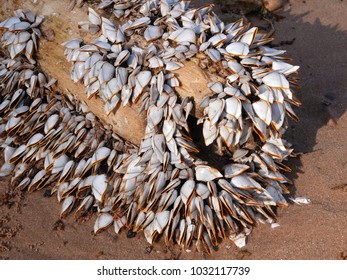Goose barnacles are tiny crustaceans that are closely related to crabs and lobsters. They have a peduncle that anchors them to the seafloor, and they are covered by plates that vary in colour, texture, and size.
Goose barnacles are harvested in the spring and fall in Spain and Portugal. They are an expensive seafood item and can be difficult to find in your local grocery store.
Overview of Goose Barnacles as a Food Source
Goose Barnacles (Pollicepes polymerus) are sessile marine cirriped crustaceans that are found in the ocean intertidal zone. They are often attached to rocks, ropes or flotsam (small particles of material that float in the water) through a strong stalk called a peduncle.
They also grow on planktons (tiny organisms that drift in the water), which they eat as a food source. They are hermaphrodites, meaning that they have both female and male reproductive systems.
They can be eaten in many ways, but they are usually cooked to make them more palatable, with the shell removed and the flesh revealed. They taste a lot like oysters and clams, but with a stronger, salty flavor.
Culinary Uses and Traditional Dishes
Goose barnacles are a type of sea creature that is most commonly found attached to rocks and other floating debris in the ocean. They are often found in a large cluster and consist of five hard plates surrounded by scales with a thick-skinned, worm-like neck called a peduncle.
These shellfish are harvested as a delicacy in Spain and Portugal, with the peduncle being the part eaten. They are most commonly steam-cooked, peeled and dipped in butter.
They are also often served boiled as a traditional Portuguese dish. They can be prepared like other boiled seafood such as shrimp or mussels.
Despite their unusual appearance, these crustaceans are very tasty and highly prized in Iberia. They can be a bit pricey, with some restaurants charging up to $100 for a kilo of goose barnacles.
Availability and Market Trends
Goose Barnacles are an extremely popular delicacy in Spain, Portugal and other European countries. They’re a staple on fine-dining menus, appearing in restaurants year-round, and they’re available at many fish stores.
In the wild, they grow up to 120 mm long and have a delicate taste that is similar to crab. In order to make them more marketable, researchers have been working on ways to produce them in a laboratory.
A University of Oregon study recently moved this process one step closer by putting juvenile gooseneck barnacles in tubes that mimic the environment they live in in the wild. They grew at rates comparable to their wild counterparts, Shanks said. He hopes the results will be used by the Oregon Department of Fish and Wildlife when regulating gooseneck barnacle harvesting.
Health Benefits and Concerns
Goose barnacles are crustaceans that live in the ocean. They can be eaten as a delicacy in Portugal and Spain.
These barnacles are found on sea weed, rocks, and other marine creatures. They are a great source of vitamins and minerals.
They also contain potassium and iron, which help regulate blood pressure and promote heart health.
In addition, they are low in calories and high in omega-3 fatty acids. These nutrients make them an excellent choice for people who are trying to lose weight.
In Europe, they are commonly referred to as percebes. These barnacles resemble crab legs, and they are considered to be one of the most expensive types of seafood in the world.
Sustainability Issues
In coastal communities along the Iberian Peninsula, goose barnacles are an important source of income. They can be sold for anywhere from 20 to 120 euros per kilo depending on quality and size.
Unlike most shellfish, goose barnacles are not farmed and have to be harvested by local fisherman. It is a very dangerous process because of how the barnacles grow: on jagged rocks that are constantly pummeled by waves.
Because of this, there are several sustainability issues surrounding the harvesting and consumption of goose barnacles. One of these is ensuring the integrity of the resource by confirming its geographic origin.

